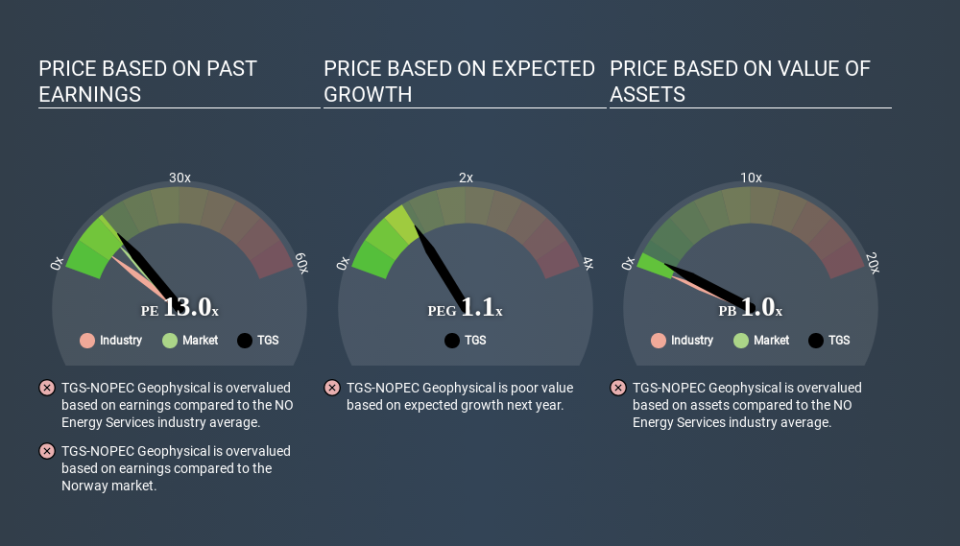How Does TGS-NOPEC Geophysical's (OB:TGS) P/E Compare To Its Industry, After Its Big Share Price Gain?

Those holding TGS-NOPEC Geophysical (OB:TGS) shares must be pleased that the share price has rebounded 38% in the last thirty days. But unfortunately, the stock is still down by 47% over a quarter. But shareholders may not all be feeling jubilant, since the share price is still down 39% in the last year.
All else being equal, a sharp share price increase should make a stock less attractive to potential investors. While the market sentiment towards a stock is very changeable, in the long run, the share price will tend to move in the same direction as earnings per share. So some would prefer to hold off buying when there is a lot of optimism towards a stock. One way to gauge market expectations of a stock is to look at its Price to Earnings Ratio (PE Ratio). Investors have optimistic expectations of companies with higher P/E ratios, compared to companies with lower P/E ratios.
Check out our latest analysis for TGS-NOPEC Geophysical
How Does TGS-NOPEC Geophysical's P/E Ratio Compare To Its Peers?
We can tell from its P/E ratio of 12.97 that there is some investor optimism about TGS-NOPEC Geophysical. As you can see below, TGS-NOPEC Geophysical has a higher P/E than the average company (7.5) in the energy services industry.
Its relatively high P/E ratio indicates that TGS-NOPEC Geophysical shareholders think it will perform better than other companies in its industry classification. Shareholders are clearly optimistic, but the future is always uncertain. So further research is always essential. I often monitor director buying and selling.
How Growth Rates Impact P/E Ratios
P/E ratios primarily reflect market expectations around earnings growth rates. If earnings are growing quickly, then the 'E' in the equation will increase faster than it would otherwise. That means unless the share price increases, the P/E will reduce in a few years. Then, a lower P/E should attract more buyers, pushing the share price up.
TGS-NOPEC Geophysical shrunk earnings per share by 40% over the last year. But EPS is up 56% over the last 3 years. And over the longer term (5 years) earnings per share have decreased 13% annually. This growth rate might warrant a below average P/E ratio.
Don't Forget: The P/E Does Not Account For Debt or Bank Deposits
One drawback of using a P/E ratio is that it considers market capitalization, but not the balance sheet. In other words, it does not consider any debt or cash that the company may have on the balance sheet. The exact same company would hypothetically deserve a higher P/E ratio if it had a strong balance sheet, than if it had a weak one with lots of debt, because a cashed up company can spend on growth.
Spending on growth might be good or bad a few years later, but the point is that the P/E ratio does not account for the option (or lack thereof).
Is Debt Impacting TGS-NOPEC Geophysical's P/E?
With net cash of US$338m, TGS-NOPEC Geophysical has a very strong balance sheet, which may be important for its business. Having said that, at 21% of its market capitalization the cash hoard would contribute towards a higher P/E ratio.
The Bottom Line On TGS-NOPEC Geophysical's P/E Ratio
TGS-NOPEC Geophysical's P/E is 13.0 which is above average (11.2) in its market. The recent drop in earnings per share might keep value investors away, but the relatively strong balance sheet will allow the company time to invest in growth. Clearly, the high P/E indicates shareholders think it will! What is very clear is that the market has become more optimistic about TGS-NOPEC Geophysical over the last month, with the P/E ratio rising from 9.4 back then to 13.0 today. For those who prefer to invest with the flow of momentum, that might mean it's time to put the stock on a watchlist, or research it. But the contrarian may see it as a missed opportunity.
When the market is wrong about a stock, it gives savvy investors an opportunity. As value investor Benjamin Graham famously said, 'In the short run, the market is a voting machine but in the long run, it is a weighing machine. So this free visualization of the analyst consensus on future earnings could help you make the right decision about whether to buy, sell, or hold.
Of course, you might find a fantastic investment by looking at a few good candidates. So take a peek at this free list of companies with modest (or no) debt, trading on a P/E below 20.
If you spot an error that warrants correction, please contact the editor at editorial-team@simplywallst.com. This article by Simply Wall St is general in nature. It does not constitute a recommendation to buy or sell any stock, and does not take account of your objectives, or your financial situation. Simply Wall St has no position in the stocks mentioned.
We aim to bring you long-term focused research analysis driven by fundamental data. Note that our analysis may not factor in the latest price-sensitive company announcements or qualitative material. Thank you for reading.

 Yahoo Finance
Yahoo Finance 
